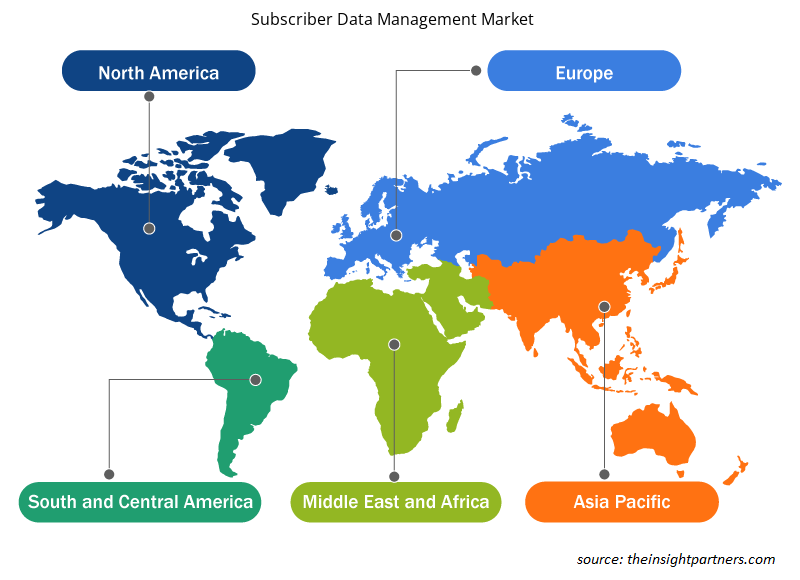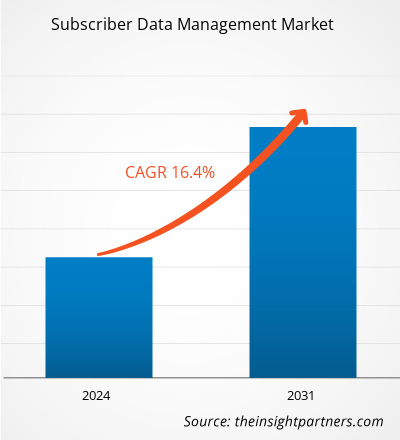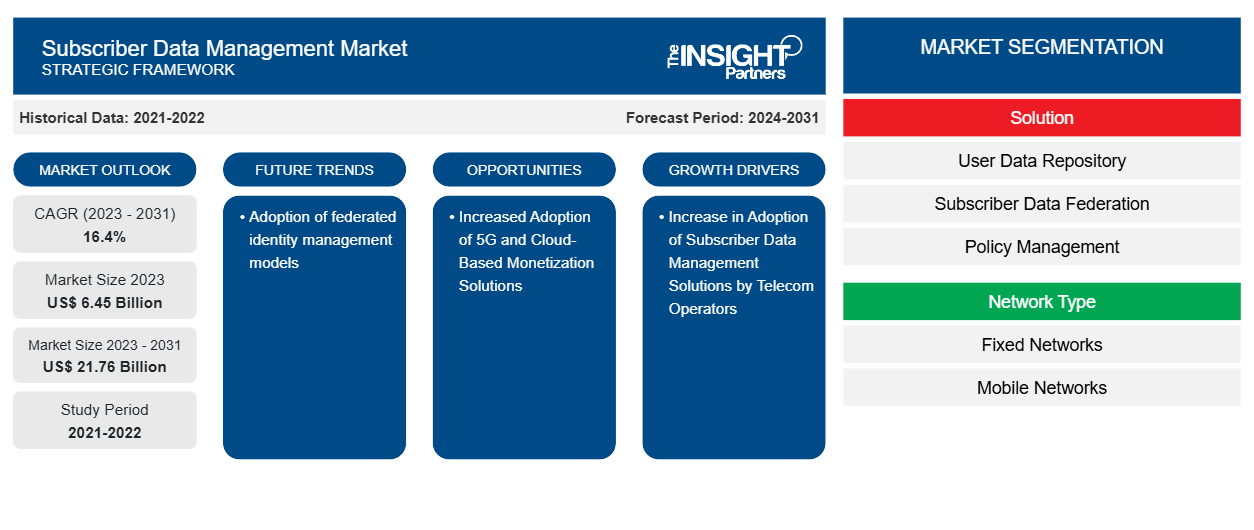Si prevede che la dimensione del mercato della gestione dei dati degli abbonati raggiungerà i 21,76 miliardi di dollari entro il 2031, rispetto ai 6,45 miliardi di dollari del 2023. Si prevede che il mercato registrerà un CAGR del 16,4% nel periodo 2023-2031. È probabile che l'adozione di modelli di gestione delle identità federate rimanga una tendenza chiave nel mercato.
Analisi di mercato della gestione dei dati degli abbonati
L'aumento del numero di utenti e dispositivi mobili, nonché l'implementazione della virtualizzazione delle funzioni di rete (NFV) e dei sistemi IP, insieme alla crescente domanda di tecnologie LTE e VoLTE da parte degli abbonati, stanno determinando una domanda di gestione dei dati degli abbonati.
Panoramica del mercato della gestione dei dati degli abbonati
Subscriber Data Management (SDM) si riferisce al modo in cui le reti di telecomunicazioni gestiscono in modo efficiente i dati dei propri consumatori in un'unica posizione. La prassi del settore per la gestione dei dati era quella di impiegare repository separati in base alla posizione dell'abbonato, alla rete (ad esempio, 2G/3G/5G) e ad altri fattori. SDM è una soluzione di buon senso che consolida tutti i dati degli abbonati per una gestione dei dati utente più efficiente e sicura. La soluzione SDM unifica e gestisce i dati degli abbonati dei gestori di rete, tra cui preferenze di accesso, servizi, posizioni, autenticazione, identità e presenza, in repository di dati unificati. Inoltre, migliora le reti dei gestori riducendo i costi operativi mantenendo un servizio coerente per gli utenti. Consente inoltre agli operatori di esaminare i dati degli abbonati in modo centralizzato, consentendo loro di monetizzare i propri dati degli abbonati in modo più efficace. SDM aiuta inoltre gli operatori di telecomunicazioni a ridurre la complessità della rete, il costo totale di proprietà e il time-to-market per i nuovi servizi.
Personalizza questo report in base alle tue esigenze
Riceverai la personalizzazione gratuita di qualsiasi report, comprese parti di questo report, o analisi a livello nazionale, pacchetto dati Excel, oltre a usufruire di grandi offerte e sconti per start-up e università
-
Scopri le principali tendenze di mercato in questo rapporto.Questo campione GRATUITO includerà analisi di dati che spaziano dalle tendenze di mercato alle stime e alle previsioni.
Driver di mercato e opportunità per la gestione dei dati degli abbonati
Aumento dell'adozione di soluzioni di gestione dei dati degli abbonati da parte degli operatori di telecomunicazioni per favorire il mercato
La soluzione di gestione dei dati degli abbonati (SDM) converge la gestione dei dati degli abbonati su diversi domini di rete. La soluzione SDM unifica e gestisce i dati degli abbonati dei gestori di rete, tra cui preferenze di accesso, servizi, posizioni, autenticazione, identità e presenza, in repository di dati unificati. Inoltre, migliora le reti dei gestori riducendone i costi operativi e mantenendo un servizio coerente per gli utenti. Consente inoltre agli operatori di esaminare i dati degli abbonati in modo centralizzato, consentendo loro di monetizzare i propri dati degli abbonati in modo più efficace. SDM aiuta inoltre gli operatori di telecomunicazioni a ridurre la complessità della rete, il costo totale di proprietà e il time-to-market per i nuovi servizi.
La necessità di ridurre le spese operative e facilitare la convergenza tra reti, così come l'aumento della domanda degli abbonati per LTE e VoLTE, l'implementazione di IMS e il passaggio delle telco alle tecnologie NFV, stimoleranno la crescita del mercato della gestione dei dati degli abbonati tra le imprese di telecomunicazioni. Inoltre, terze parti possono aiutare gli operatori di telecomunicazioni a fornire servizi nuovi e migliorati fornendo nuove catene del valore che vengono riconosciute lentamente ma costantemente. Le aziende di telecomunicazioni stanno esaminando la possibilità di fornire gradi simili di personalizzazione e monitoraggio delle attività ai propri clienti. Le terze parti potrebbero trovare i dati degli abbonati particolarmente interessanti per migliorare i servizi che possono fornire sfruttando l'infrastruttura degli operatori di telecomunicazioni. Pertanto, la crescente adozione di soluzioni SDM da parte degli operatori di telecomunicazioni sta alimentando in modo significativo la crescita del mercato.
Maggiore adozione di soluzioni di monetizzazione basate su 5G e cloud
La crescente adozione della tecnologia 5G e delle soluzioni di monetizzazione basate su cloud sta guidando la domanda di soluzioni di gestione dei dati degli abbonati. La tecnologia 5G consente alle telecomunicazioni di raccogliere dati sui consumatori in tempo reale e prendere decisioni informate. Implementando la gestione del valore del cliente basata sull'analisi, le telecomunicazioni potrebbero aumentare i ricavi dal 5 all'8% in sole quattro settimane. L'aumento dell'elaborazione e dell'archiviazione basate su cloud, insieme all'espansione dei social media e dei contenuti video on-demand ad alta definizione, guida la necessità di soluzioni di gestione dei dati degli abbonati. L'introduzione del 5G e delle tecnologie di monetizzazione basate su cloud crea potenziale per i principali partecipanti del settore. Le società di telecomunicazioni possono stipulare accordi con i creatori di contenuti per monetizzare esperienze abilitate al 5G che attraggono un numero inferiore di utenti. Il 5G offre agli operatori due importanti opportunità commerciali: intrattenimento e gioco d'azzardo.
Analisi della segmentazione del rapporto di mercato sulla gestione dei dati degli abbonati
I segmenti chiave che hanno contribuito alla derivazione dell'analisi di mercato della gestione dei dati degli abbonati sono la soluzione, il tipo di rete, l'implementazione e l'applicazione.
- In base alla soluzione, il mercato è segmentato in base a repository di dati utente, federazione di dati degli abbonati, gestione delle policy e gestione delle identità. Il segmento del repository di dati utente ha detenuto una quota di mercato significativa nel 2023.
- In base al tipo di rete, il mercato è segmentato in reti fisse e reti mobili. Il segmento delle reti fisse ha detenuto una quota di mercato maggiore nel 2023.
- In base all'implementazione, il mercato è segmentato in cloud e on-premise. Il segmento cloud ha detenuto la quota maggiore del mercato nel 2023.
- In base all'applicazione, il mercato è segmentato in voice-over IP e mobile. Il segmento voice-over IP ha detenuto la quota maggiore del mercato nel 2023.
Analisi della quota di mercato della gestione dei dati degli abbonati per area geografica
L'ambito geografico del rapporto di mercato sulla gestione dei dati degli abbonati è suddiviso principalmente in cinque regioni: Nord America, Asia Pacifico, Europa, Medio Oriente e Africa, Sud e Centro America.
Il Nord America ha dominato il mercato nel 2023. Sulla base del rapporto della GSM Association, il Nord America avrà 100 milioni di connessioni 5G entro il 2022, a causa delle continue spese di rete da parte degli operatori e di una crescente selezione di dispositivi 5G a vari livelli di prezzo. Il Nord America sarà la prima area in cui il 5G rappresenterà più della metà di tutte le connessioni entro il 2025. Di conseguenza, il crescente numero di abbonati 5G spingerebbe gli operatori di rete a dare priorità alla corretta gestione dei piani mobili dei clienti, con conseguente aumento della domanda di gestione dei dati degli abbonati. L'epidemia di COVID-19 e i successivi lockdown imposti in paesi come Stati Uniti, Canada e Messico hanno aumentato significativamente il numero di abbonati OTT nella regione. Ad esempio, secondo lo studio del 2020 di Comscore, 69,8 milioni di case negli Stati Uniti hanno utilizzato OTT ad aprile 2020, con un aumento di 5,2 milioni rispetto all'anno precedente.
Inoltre, lo streaming musicale è sceso per tre settimane di fila a marzo 2020, quando la pandemia ha iniziato ad avere un impatto sostanziale negli Stati Uniti. Prima del 2%, poi dell'8,8% e infine del 3,2%. Tuttavia, lo streaming musicale negli Stati Uniti ha iniziato a registrare un aumento del 2% nella settimana conclusasi il 2 aprile 2020 e la tendenza è poi continuata fino a oggi. Pertanto, l'aumento degli abbonati su varie piattaforme ha avuto un impatto positivo sul mercato della gestione dei dati degli abbonati in tutta la regione durante la pandemia.
Informazioni regionali sul mercato della gestione dei dati degli abbonati
Le tendenze regionali e i fattori che influenzano il mercato della gestione dei dati degli abbonati durante il periodo di previsione sono stati ampiamente spiegati dagli analisti di Insight Partners. Questa sezione discute anche i segmenti e la geografia del mercato della gestione dei dati degli abbonati in Nord America, Europa, Asia Pacifico, Medio Oriente e Africa e America centrale e meridionale.

- Ottieni i dati specifici regionali per il mercato della gestione dei dati degli abbonati
Ambito del rapporto di mercato sulla gestione dei dati degli abbonati
| Attributo del report | Dettagli |
|---|---|
| Dimensioni del mercato nel 2023 | 6,45 miliardi di dollari USA |
| Dimensioni del mercato entro il 2031 | 21,76 miliardi di dollari USA |
| CAGR globale (2023-2031) | 16,4% |
| Dati storici | 2021-2022 |
| Periodo di previsione | 2024-2031 |
| Segmenti coperti |
Per soluzione
|
| Regioni e Paesi coperti |
America del Nord
|
| Leader di mercato e profili aziendali chiave |
|
Mercato della gestione dei dati degli abbonati Densità: comprendere il suo impatto sulle dinamiche aziendali
Il mercato del mercato della gestione dei dati degli abbonati sta crescendo rapidamente, spinto dalla crescente domanda degli utenti finali dovuta a fattori quali l'evoluzione delle preferenze dei consumatori, i progressi tecnologici e una maggiore consapevolezza dei vantaggi del prodotto. Con l'aumento della domanda, le aziende stanno ampliando le loro offerte, innovando per soddisfare le esigenze dei consumatori e capitalizzando sulle tendenze emergenti, il che alimenta ulteriormente la crescita del mercato.
La densità degli operatori di mercato si riferisce alla distribuzione di aziende o società che operano in un particolare mercato o settore. Indica quanti concorrenti (operatori di mercato) sono presenti in un dato spazio di mercato in relazione alle sue dimensioni o al valore di mercato totale.
Le principali aziende che operano nel mercato della gestione dei dati degli abbonati sono:
- Cisco Systems, Inc.
- Sviluppo aziendale Hewlett Packard LP
- Società controllata da Huawei
- Società Nokia
- Società Oracle
- Telefonaktiebolaget LM Ericsson
Disclaimer : le aziende elencate sopra non sono classificate secondo un ordine particolare.

- Ottieni una panoramica dei principali attori del mercato della gestione dei dati degli abbonati
Notizie di mercato e sviluppi recenti sulla gestione dei dati degli abbonati
Il mercato della gestione dei dati degli abbonati viene valutato raccogliendo dati qualitativi e quantitativi dopo la ricerca primaria e secondaria, che include importanti pubblicazioni aziendali, dati associativi e database. Di seguito sono elencati alcuni degli sviluppi nel mercato della gestione dei dati degli abbonati:
- Cisco ha annunciato il completamento dell'acquisizione di Socio Labs, Inc. Attraverso questo; l'azienda mira ad ampliare le offerte WebEx oltre riunioni, webinar e webcast per includere conferenze e alimentare il futuro degli eventi ibridi. Socio Labs è una moderna piattaforma tecnologica per eventi che gestisce l'intero ciclo di vita di conferenze virtuali multi-sessione, multi-traccia, di persona e ibride. (Fonte: Cisco, comunicato stampa, luglio 2021)
- Cisco ha stretto una partnership con Vodafone Idea Limited per semplificare e automatizzare la rete per supportare i casi d'uso 4G e 5G. Offre inoltre un'esperienza di migliore qualità per i suoi clienti consumer, retail e enterprise. Per questo, Vodafone Idea sta implementando l'Ultra Packet Core di Cisco in tutta l'India per accelerare la trasformazione digitale. (Fonte: Cisco, comunicato stampa, giugno 2021)
Copertura e risultati del report di mercato sulla gestione dei dati degli abbonati
Il rapporto "Dimensioni e previsioni del mercato della gestione dei dati degli abbonati (2021-2031)" fornisce un'analisi dettagliata del mercato che copre le seguenti aree:
- Dimensioni e previsioni del mercato della gestione dei dati degli abbonati a livello globale, regionale e nazionale per tutti i segmenti di mercato chiave coperti dall'ambito
- Tendenze del mercato della gestione dei dati degli abbonati e dinamiche di mercato come driver, vincoli e opportunità chiave
- Analisi dettagliata delle cinque forze PEST/Porter e SWOT
- Analisi di mercato della gestione dei dati degli abbonati che copre le principali tendenze del mercato, il quadro globale e regionale, i principali attori, le normative e i recenti sviluppi del mercato
- Analisi del panorama industriale e della concorrenza che copre la concentrazione del mercato, l'analisi della mappa di calore, i principali attori e gli sviluppi recenti per il mercato della gestione dei dati degli abbonati
- Profili aziendali dettagliati
- Analisi storica (2 anni), anno base, previsione (7 anni) con CAGR
- Analisi PEST e SWOT
- Valore/volume delle dimensioni del mercato - Globale, Regionale, Nazionale
- Industria e panorama competitivo
- Set di dati Excel
Report recenti
Rapporti correlati
Testimonianze
Motivo dell'acquisto
- Processo decisionale informato
- Comprensione delle dinamiche di mercato
- Analisi competitiva
- Analisi dei clienti
- Previsioni di mercato
- Mitigazione del rischio
- Pianificazione strategica
- Giustificazione degli investimenti
- Identificazione dei mercati emergenti
- Miglioramento delle strategie di marketing
- Aumento dell'efficienza operativa
- Allineamento alle tendenze normative























 Ottieni un campione gratuito per - Mercato della gestione dei dati degli abbonati
Ottieni un campione gratuito per - Mercato della gestione dei dati degli abbonati